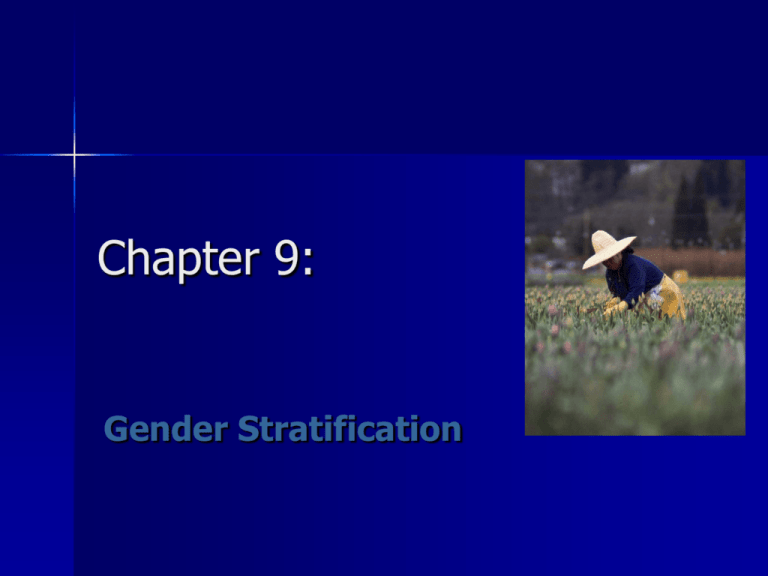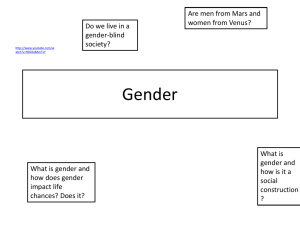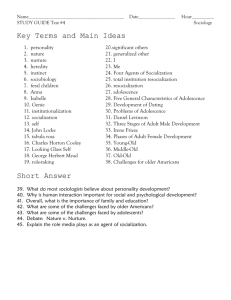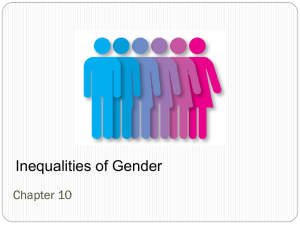Introduction to Sociology
advertisement

Chapter 9: Gender Stratification What to Expect in This Chapter... The Concepts of Sex and Gender Viewpoints on the relation between men and women Theories of Gender Inequality Gender Role Socialization Gender Inequality and Work The Concepts of Sex and Gender Sex refers to the physical and biological attributes of men and women – These attributes are anatomical, hormonal, chromosomal, and physiological in nature Gender refers to the social, psychological and cultural attributes of masculinity and femininity, many of which are based on biological distinctions – Gender includes people’s self image and expectations for behavior among other things Generally, sex is considered to be an ascribed status while gender is an achieved status Viewpoints on the Relation Between Males and Females Historical Views on Males and Females Historically, women have been viewed as inferior to men, both in the east and in the west Auguste Comte, founding father of sociology, believed that women were physically and mentally inferior to men Comte believed that women should not work outside the home, own property, or hold political power Religious Views on Males and Females Many of the major religions of the world have characterized men as superior to women: – – – – Christianity Judaism Islam Hinduism Some interpretations of the religious texts of these religions has given rise to a patriarchal ideology, the belief that men are naturally superior and should control all important aspects of society Biological Views on Males and Females Supporters of the view that male and female attributes are biologically determined provide evidence from two sources: – Studies of animals, especially primates such as monkeys and apes – Studies of physiological differences between men and women Studies of Primates The study of animal behavior is known as ethology Ethologists have observed a number of general patterns among primates: – Male dominance – Sexual division of labor Sociobiologists extend this understanding to explain human behavior to be the result of genetic differences between males and females Critics assert that learning plays a much larger role than sociobiologists allow Studies of Physiological Differences Between Men and Women Recent studies have found that men and women are variable susceptible to different types of diseases Studies also find that men and women tend to react very differently to stress It is not entirely clear how much these differences are due to genetic and other biological factors and how much to cultural and environmental factors Gender and Disease Disease Heart Attack Cancer Osteoporosis Immunologic Diseases Mental Disorders Gender Most Affected Men more likely to suffer heart attacks and cardiovascular disease; Heart attacks are more fatal in women Second leading cause of death for women: lung cancer heads the list followed by breast cancer Women are primarily affected by this disease Affect women much more than men: Autoimmune thyroid diseases 15:1; rheumatoid arthritis 3:1 Mental illness is twice as high among women This disease is higher among women and increases Alzheimer’s Disease greatly after age 85 Visual/Hearing Impairments Men are 50% more likely to experience these symptoms Sociological View A pioneering work in focusing our attention on cultural factors was Margaret Mead’s Sex and Temperament – Mead found evidence of widely varying roles for males and females in the three cultures she studied – Mead’s research has come under some criticism and should be interpreted cautiously Subsequent research generally supports the idea that men are much more aggressive and are involved in hunting and other more aggressive aspects of community life Margaret Mead 1901-1978 Theories on Gender Inequality Functionalist Theory on Gender Inequality Functionalists suggest that since women give birth and nurse a child, it is natural that they will take care of it in other ways These duties lead to a natural division of labor, in which women are more involved in domestic activities such as preparing meals and maintaining a home Men, therefore are left to engage in breadwinning activities and other economically dominant roles Parsons and Bales refer to the roles of men and women as instrumental roles and expressive roles respectively Conflict Theory on Gender Inequality Focuses on why gender inequality persists, even though men and women are not tied to traditional roles as might have been the case in earlier times Suggests that men continue to dominate women because of their greater control over economic, political and social resources Because there is no incentive for those in power to give up this control, these arrangements persist far beyond their functional necessity Cultural Study: Honor and Shame Who takes the credit? Who takes the blame? How are concepts of honor and shame expressed in your culture? How is a shameful act dealt with? How is honor restored to the family reputation? Are credit and blame shared equally across gender lines? Gender Role Socialization Gender role socialization is “...a lifelong process whereby people learn the values, attitudes, motivations, and behavior considered appropriate to each sex by their culture” Gender role socialization takes place from earliest childhood through adolescence and throughout all social interactions in which we participate Gender Role Socialization in Childhood From the time we are born we are being socialized along gender lines – Girls wear pink, have bonnets and ribbons, are allowed to cry, and are caressed more than boys – Boys wear blue, are expected to be strong, and not allowed to cry This socialization takes place not only by parents but also by siblings, peers, schools and the mass media Gender Role Socialization in Adolescence Adolescence is a critical time for establishing gender identity – Girls are encouraged to be passive and less achievement oriented – Boys are encouraged to be competitive, autonomous and independent Because gender roles are changing in the culture at large, adolescence can be even more uncertain with regard to gender identity than it once was Gender Differences in Men and Women Research shows that men and women experience the world differently – Men have a sense of autonomy, that they can accomplish what they set out to do – Women feel more limited in the control they have over their future Men and women also tend to think and reason differently – Men tend to be decisive, rational and firm – Women tend to consider “gray areas,” recognize complexities, and are more concerned about the feelings of others which often comes across as indecisive Gender Inequality and Work More than 60% of American women are in the paid labor force In 1999, women earned approximately 77% of what men did Even within occupational categories, and controlling for educational level, women earn significantly less than men Women experience discrimination on the job in three ways: – During the hiring process, they are given jobs with lower prestige – Through unequal wage policies – Promotional practices Women’s Median Pay as Percentage of Men’s: 18901999 90 80 70 60 50 40 30 20 10 0 1890 1900 1910 1920 1930 1940 1950 1960 1970 1980 1990 1999








